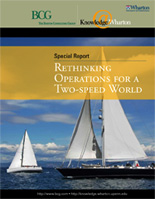 Global companies face a radically altered business landscape following the Great Recession, most notably a slowdown in world economic growth compared to levels predating the global financial crisis. What’s more, the growth pattern is uneven. A "two-speed" world is emerging, characterized by slow growth in the developed countries of Europe, North America and Japan, and faster growth in rapidly developing economies such as China, India and Brazil. To succeed in this "new normal," companies must develop different strategies, new products, and innovative, low-cost operating models. This special report explores how companies must re-think every aspect of their operations to compete in two fundamentally different environments.
Global companies face a radically altered business landscape following the Great Recession, most notably a slowdown in world economic growth compared to levels predating the global financial crisis. What’s more, the growth pattern is uneven. A "two-speed" world is emerging, characterized by slow growth in the developed countries of Europe, North America and Japan, and faster growth in rapidly developing economies such as China, India and Brazil. To succeed in this "new normal," companies must develop different strategies, new products, and innovative, low-cost operating models. This special report explores how companies must re-think every aspect of their operations to compete in two fundamentally different environments.
Strategies for a Two-speed World
Competing successfully in this new decade requires companies to meet the needs of both low-growth and high-growth markets while differentiating themselves from foreign and local competitors. Building a low-cost global production network that taps into the strengths of each geographical region is critical. Also crucial to success: innovating products, processes and business models to increase margins wherever possible — and to gain market share. Key decisions will involve looking at profit vs. growth, best price vs. best value, and new rewards systems.
Manufacturing in a Two-speed World
Whether a company operates in a high-growth or slow-growth market, lean products and systems are a must. They allow companies in low-growth markets to respond quickly to customer needs, and in high-growth markets they keep costs down while supporting customization and rapid increases in output when needed. Another step up in efficiency: shared production platforms that allow high-end and low-end products to be built at the same facility — sometimes even on the same assembly line. But all of these considerations — including geographic location and labor costs — must be balanced against logistical costs and risks. Customers want lower cost and quick delivery.
Winning in Two Worlds: Supply Chain Flexibility
Companies must create adaptable supply chains in a two-speed world that work for both slow- and fast-growing markets — without sacrificing sales volumes or margins. In high-growth emerging economies, this often means creating high volumes of low-cost — and sometimes low-margin — products, and distributing them at the lowest possible cost. In low-growth developed economies, supply chains must enhance efforts to defend or steal market share through better and faster innovation, and exceptional service.
Innovation — the New Two-way Play
It takes a lower price or a better mousetrap to win over potential customers. This is especially true in the developed world, but to gain a foothold in rapidly growing economies, successful multinationals increasingly will have to unleash new products and services while paying strict attention to costs. "We need better products, faster, at a lower cost," says Joe Manget, global leader of The Boston Consulting Group’s operations practice. In a break with the past, many ideas for these new products and services now originate in developing countries. Watch for more successful global companies to take this approach.


